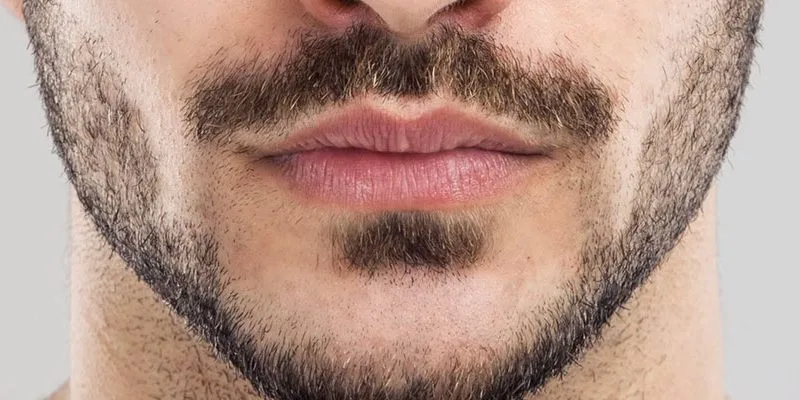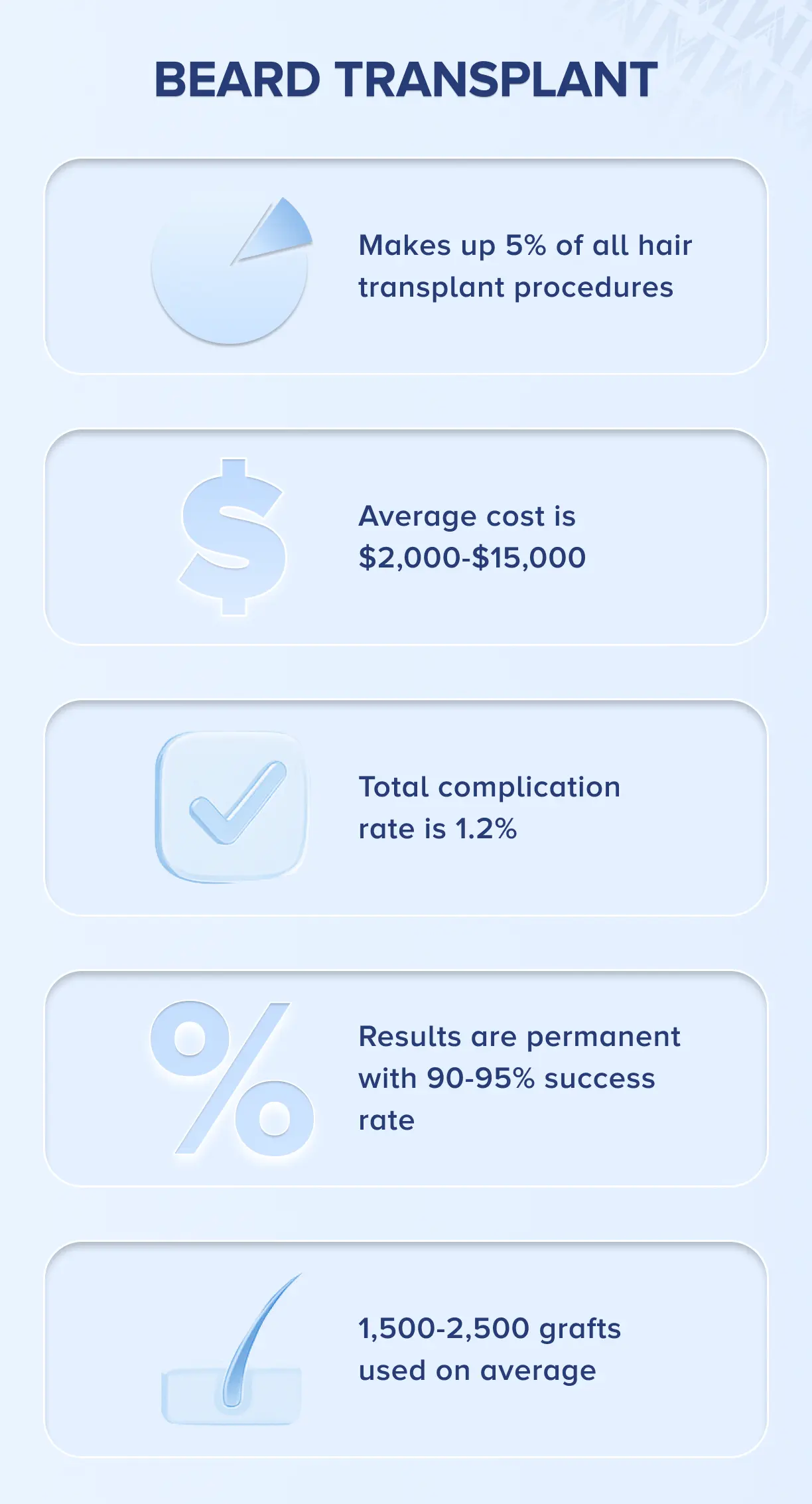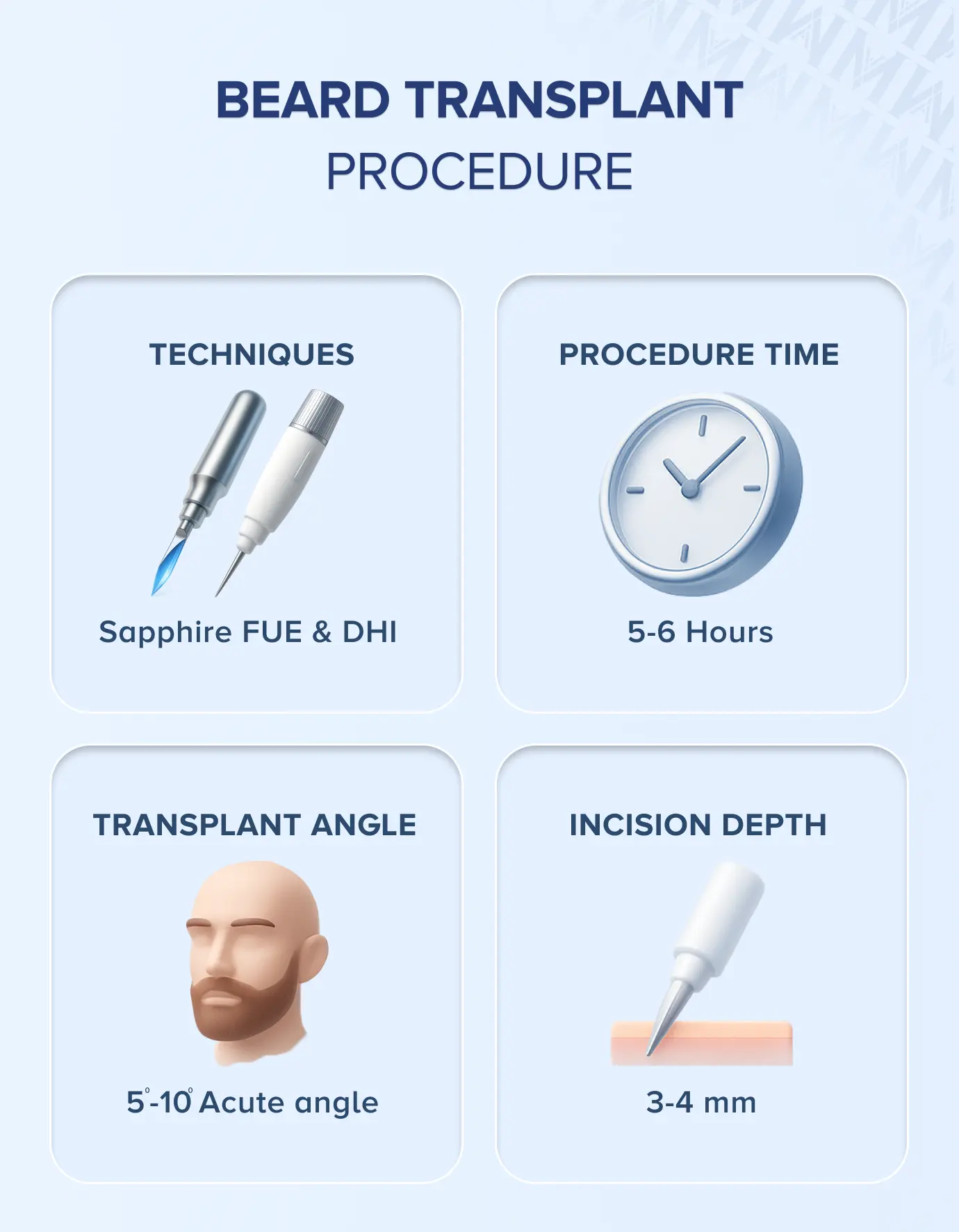Is a beard transplant safe?
Yes, beard transplant is a safe procedure as all hair transplantation procedures are extremely low risk compared to other cosmetic procedures, with high success rates.
What are the risks of beard transplant?
A beard transplant has the same risks as a hair transplant, such as shock loss, scarring, bleeding, infection, folliculitis, and necrosis. These complications are extremely rare (less than 1% of likelihood,) and hair transplants are considered one of the safest cosmetic surgeries.
What are the complications of beard transplant?
Beard transplants have an exceptionally low total complication rate at 1.2%, according to research by Alfonso Barrera from the Department of Plastic Surgery, Baylor College of Medicine in Texas.
In this 1.2% rate, 0.4% accounts for keloid scarring, 0.4% accounts for poor hair growth, and 0.4% accounts for hair loss at the donor site (when performed with the FUT method).
Additional complications can include post-inflammatory hyperpigmentation, placement of grafts at the wrong angle, folliculitis, and cobblestoning (bumps) around the mustache and goatee area.
What are the side effects of beard transplant?
The most common side effects of beard transplants are redness and swelling, which can last up to a couple of days and is more common with patients with pale or thinner skin.
How long does the swelling last after beard transplant?
The swelling lasts for 3 to 5 days after a beard transplant.
Does shock loss occur with beard transplant?
Shock loss can occur with beard transplants at any point after 2 weeks, but the prevalence is not as high as with hair transplants.
Does beard transplant leave scars?
Beard transplant does not leave scars if done correctly using the Sapphire FUE and DHI techniques.
What to do before a beard transplant?
Stop alcohol, smoking, vitamins, blood thinners, supplements
Before a beard transplant surgery, stop any medications according to your doctor’s instructions. If you use hair loss treatments, stop Finasteride 7 days and Minoxidil 10 days before the procedure. Most importantly, discuss with your doctor about pausing blood thinners a week before surgery, as this requires careful medical supervision.
While it’s essential to avoid smoking, alcohol, and recreational drugs for at least 48 hours before surgery, abstaining for two weeks provides better outcomes.
Do you need to shave your beard before a beard transplant?
No, you don’t need to shave your beard before a beard transplant. In fact, we need to asses patients with their beard grown, so we can determine the correct number of grafts required and determine the direction their natural beard grows in. We will shave the beard to an optimal length before the surgery.
How to choose a beard transplant clinic?
To choose a beard transplant clinic, first look at the accreditations and the licenses of the clinic. Surgeons must have specific training in facial hair transplantation. Check their before-and-after portfolio, particularly for cases similar to your beard pattern. Look for clinics that use advanced techniques like DHI or Sapphire FUE and offer realistic expectations rather than exaggerated promises. Finally, ensure they provide comprehensive pre-op consultations and long-term aftercare support, including detailed beard growth timeline guidance.
What questions to ask during a beard transplant consultation?
You should ask the following questions during a beard transplant consultation.
“How many grafts can be safely extracted from my donor area for the beard design I want?”
“How well does my scalp hair match my beard hair?”
“Will I have enough donor supply for a hair transplant in the future if I get a beard transplant now?”
How long does beard transplant recovery take?
Beard transplant recovery takes around 10 days for both the recipient and the donor area to fully heal.
How long does the donor area take to heal after beard transplant?
The donor area takes about 7-10 days to fully heal after a beard transplant.
What to do and avoid after beard transplant?
After a beard transplant, avoid smoking and caffeine for at least 3 days to increase blood flow and prevent necrosis of the skin. Avoid exercising and sweating. Avoid staying in the sun.
How to manage beard transplant aftercare?
To manage beard transplant aftercare, start with getting enough sleep through the night to accelerate healing. Keep your beard moisturized and protected from the sun. Consume foods rich in protein.
When can you wash your face after beard transplant?
You can gently wash your face without rubbing the day after a beard transplant.
The general consensus is that patients should wait at least 5 days after the surgery to wash their face to increase retention rates, but gentle rinsing the day after surgery is permitted.
How long after beard transplant can i shave?
You can shave with a clipper guard or cut your beard with scissors 4 weeks after a beard transplant.
When can you style your beard after a beard transplant?
You can style your beard with oils, waxes, heat, and dyes 6 months after surgery to give the best chance of growth without interfering with the process.
How to protect your beard from the sun after a beard transplant?
To protect your beard from the sun after a beard transplant, wear at least SPF 30 on your beard every day, wear a wide-brim hat, seek shade, and drink plenty of water for at least 6 months.
When can you return to normal activities after beard transplant?
You can return to normal daily activities 1 week after a beard transplant.
How do you eat after a beard transplant?
When eating after a beard transplant, you can opt for liquid or pureed foods such as juices, smoothies, soups, or stews for the first 3 days.
If you’d like to consume solid foods, avoid opening your mouth too wide and take smaller bites. This process will only last a couple of days as beard transplants heal quickly.
How to sleep after a beard transplant?
After a beard transplant, sleep upright at a 45° angle and avoid contact with your face for 10 days. You can use an extra pillow to prop your back and a neck pillow to avoid contact.
When can you exercise after beard transplant?
You can start exercising 1 week after a beard transplant with light cardio, such as walking. You must avoid sweating for at least 2 weeks. After a month, you can return to your regular exercise routine.
When can you return to work after beard transplant?
You can return to work 3 days after a beard transplant if you have a desk job, but it’s best to wait at least 1 week. If you perform physical labor or work in a particularly dusty environment, wait at least 2 weeks before going to work.
When can you see beard transplant results?
You can start seeing the results of beard transplant at 4 months, and full results will be evident around 10-12 months.
How thick the transplanted hair will grow?
The transplanted hair will grow as thick as the donor hair. If you naturally have finer hair, your beard translate donor hairs will also be fine, and a denser look can require the implantation of 2 hair or 3 hair grafts. If you naturally have thick hair, single follicle grafts will be implanted and will be the same thickness as your hair.
Can transplanted hairs fall out?
Some transplanted hairs can fall out after beard transplant. A rate of 5% to 10% loss in the transplanted hairs is considered normal and is taken into account when designing the beard.
Is a beard transplant permanent?
Yes, a beard transplant is permanent.
How to maintain beard transplant results?
To maintain beard transplant results, you must keep your beard moisturized with a simple and natural moisturizer at all times. You can also start using minoxidil to increase the growth of the beard 15 days after surgery.
Can you do a revision beard transplant if needed?
Yes, you can do a revision hair transplant if you’d like to increase density, or to correct a previously botched beard transplant.





